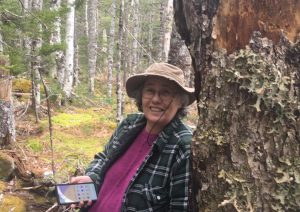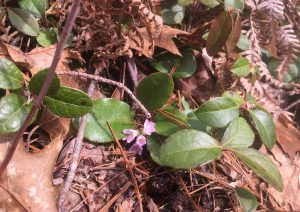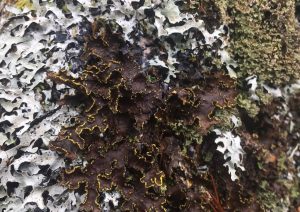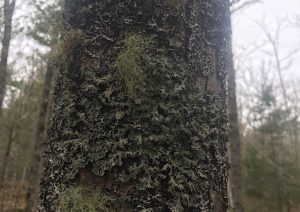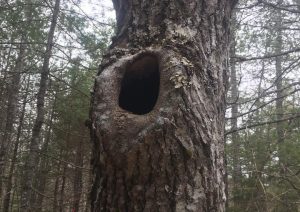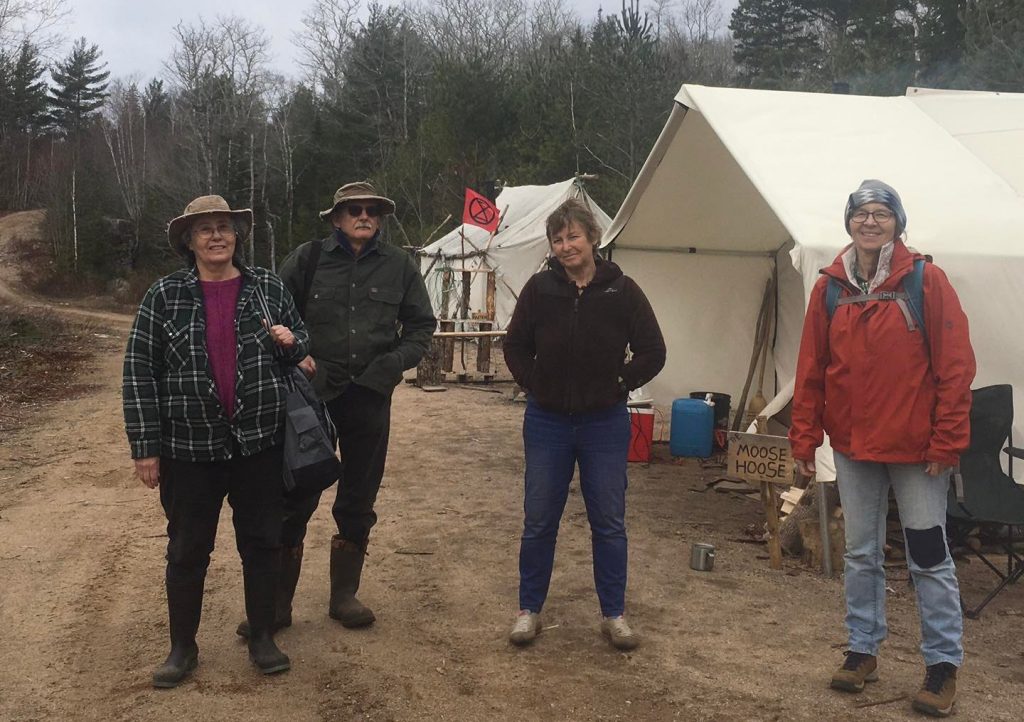From Nina Newington’s post, “Day 137 at the Last Hope camp” on Extinction Rebellion Mi’kma’ki / Nova Scotia, today (April 17, 2022):
“At every opportunity, humans need to feel the power, order, beauty and greater life force of the natural world, to remember that our survival depends on us fitting into it, to remember that when we fight for nature, we are on the big team.” Alexandra Morton, Not On My Watch
After Thursday’s tour through nearby clearcuts, it was balm to spend the day in the Last Hope forest, looking for — and finding — more Species at Risk lichens.
We were looking for some lichens in particular but we saw so much more. Saw and heard and felt and smelled. Yes, the very first Mayflowers were blooming. They merited kneeling on the mossy earth and inhaling the sweet breath of a tiny flower. All the while a pileated woodpecker hammered away. Nature’s demolition expert breaks down dead and rotting trees chunk by chunk in the course of finding lunch.
Like the rare lichens we’ve been finding, pileated woodpeckers need old, undisturbed forests. The oaks at Last Hope are not huge and spectacular. The pines are bigger but they grow fast. This is not the kind of forest people compare to a cathedral. But the more time you spend in it, the more you feel and see the complexity of it. The sheer variety of mosses, for example. What you are experiencing is a forest that has seen very little disturbance over the last 80 years.
In January, after the first endangered lichens were discovered at Last Hope, Linda Pannozzo interviewed Brad Toms of the Mersey Tobeatic Research Institute about the finds: ‘According to Toms, lichenologists and ecologists are often able to “read the forest.” He says an important common characteristic among the habitat of the three lichen species identified at Beals Brook is what he calls “site permanence.”
“Whether upland or forested wetland these sites consistently seem to be sites that have not had any major disturbance in a long time in the area around the lichen host tree. So while not ‘old growth’ by provincial definition these are forests that have been allowed to be in a natural climax state for an extended period of time possibly even longer than ‘old growth’ forest with longer lived species.”
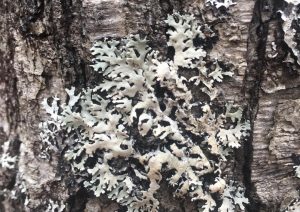
Black foam lichen, Anzia colpodes, Species At Risk, found April 16th, 2022 Last Hope forest by Beal’s Brook
Toms says that when forests have a major disturbance (natural or anthropogenic) the lichen diversity usually takes a hit and is “often altered for a long time and takes likely on the scale of a hundred years (or more) to be restored.” – Cited by Linda Pannozzo in a post on The Quaking Swamp Journal Feb 15, 2022: The Last Hope Camp, Protecting endangered spaces and species, one forest at a time
So yes, on Saturday, we discovered two more occurrences of the Species At Risk Black-foam lichen, Anzia colpodes, in parts of the forest where no protected lichen have been found until now. We will of course report these. These discoveries are in addition to two other finds made during the Lichen Identification session led by Frances Anderson on April 3rd.
Will DNRR put another freeze on the proposed harvest? Hire another lichenologist to come out and confirm these new finds? Commission a fuller survey now that there is no longer two and a half feet of snow on the ground? Perhaps check for the endangered wood turtle local resident Randy Neily reports having seen laying eggs at the edge of this logging road a couple of years ago? Or might they wait for the migratory birds to arrive?
Undisturbed forest of the sort found at Beal’s Brook is a rarity. DNRR chose to ignore the knowledge of local people who have known and loved this place for generations. They admitted their biologists never even came and looked at this forests. They mentioned a shortage of experts and the need for citizen scientists.
Well, we are educating ourselves. The question is, what will DNRR do with the information citizens provide? They could demonstrate that the changes in culture called for by the Lahey report are finally happening. What would a department that places the protection and enhancement of ecosystem health above all other considerations, including economic ones — Lahey’s core recommendation — do? Would they grudgingly keep adding 100 meter buffers for each SAR lichen find? Or would they admit they made a mistake by approving the harvesting of this forest and recommend that it be protected as part of the government’s excellent commitment to protect 20% of our province in the next eight years?

